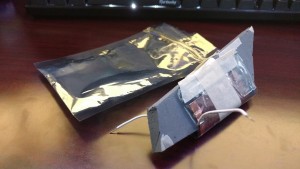This week at the fab lab, I was at the Arduino station. Admittedly, this was not the first time I had used an Arduino so I was under the impression that it was going to be a pretty slow afternoon, but I quickly realized that would not be the case. After the ubiquitous blinking led and motor tutorials, we put together a rudimentary capacitive touch sensor. Talking with Colton, who was leading the workshop, we quickly realized this could be utilized to build a force sensor. That started an afternoon of experimentation where we tried to come up with the best way to design the sensor by experimenting with different materials to keep between the copper pads and whether insulating the pads had any effect. Our final design had us using a 6.8 megaohm resistor and a piece of (iirc) DMX foam between the two copper pads. The foam is extremely dense so it does not fully compress under normal force, which would have the effect of “topping out” our sensor, a problem we were having with other foams. Also, the pads worked best when surrounded by Mylar bags (to insulate from other some other electrical interference) and when one pad was connected to the resistor and the other was grounded. We also soldered wires to the copper to keep the thickness uniform, since that was a problem with alligator clips.

This is a very rough first iteration. For starters we have no calibration on the device. The raw data we get is useful for relative measurements, but cannot give us an accurate representation of how many grams, Newtons, etc of force is being applied. To do that we would need to put the device on a scale and apply some known loads to it and then scale our raw data to that. Also, I suspect that the foam does not compress linearly, so we will have to do some research on the properties of the foam. Overall I’m very happy with the progress we made and I’m optimistic about the project as a whole.

